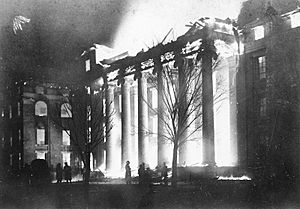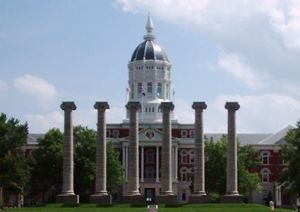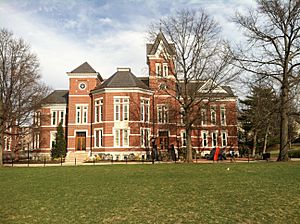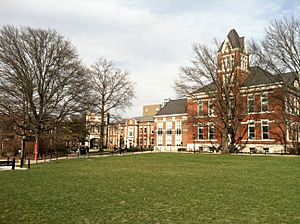Francis Quadrangle facts for kids
Quick facts for kids |
|
|
David R. Francis Quadrangle Historic District
|
|
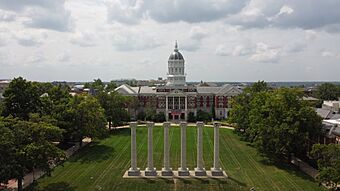 |
|
| Location | Bounded by Conley Ave. and Elm, 6th, and 9th Sts., Columbia, Missouri |
|---|---|
| Area | 32.9 acres (13.3 ha) |
| Built | 1867 |
| Architect | Morris Frederick Bell, William Lincoln Garver |
| Architectural style | Late 19th And 20th Century Revivals, Late Victorian |
| NRHP reference No. | 73001036 |
| Added to NRHP | December 18, 1973 |
The David R. Francis Quadrangle, often called The Quad, is the historic heart of the University of Missouri in Columbia, Missouri. It's the oldest part of the university's "Red Campus" and sits right next to Downtown Columbia.
At the center of The Quad are six tall Ionic columns. These are all that remain of the university's first main building, Academic Hall, which burned down a long time ago. Twelve buildings surround the modern Quad, including Jesse Hall, the main administration building with its famous dome. Jesse Hall is also the tallest building in Columbia!
The Quad was designed by architect Morris Frederick Bell and his assistant William Lincoln Garver. It's named after Missouri governor David R. Francis, who helped rebuild the university after the fire. Many buildings here, including the entire Quad, are part of the Francis Quadrangle National Historic District.
You can also find interesting monuments here. An obelisk, which was the original tombstone of Thomas Jefferson, stands near the Chancellor's Residence. It was given to the university by Jefferson's family because Missouri was part of the land he bought for the U.S. (the Louisiana Purchase). Other markers honor important people like university president Richard Henry Jesse and Governor David R. Francis. The Missouri School of Journalism is also located at The Quad's northeast corner.
Contents
A Look Back: The Quad's History
When the University of Missouri first started, there was only one main building called Academic Hall. It was built between 1840 and 1843 from red brick and limestone. For many years, this was the only place where students had classes. In 1843, a large house was built next door for the university's president.
During the American Civil War, soldiers used Academic Hall. They even burned parts of the library for firewood! Academic Hall was damaged, and the president's house was destroyed in 1865. After the war, the university won a lawsuit against the government for the damage. The money helped build the Memorial Gateway, which you can see today. A new President's Mansion was built in 1867 and is still standing. As the university grew, a new building called Scientific Hall (now Switzler Hall) was built in 1872.
The Great Fire of 1892
A big change happened on a cold night in January 1892 when Academic Hall caught fire and burned down. Many people in the Missouri Legislature wanted to move the university to another city, Sedalia. But Missouri's Governor, David R. Francis, promised to keep the university in Columbia. He even came to speak to the people, teachers, and students.
Governor Francis called a special meeting of the state legislature. He helped the university get $250,000 to rebuild. This money was used to create the Quad as we know it today. A new main building, first called "New Academic Hall" and later Jesse Hall, was built on the south side. The Avenue of the Columns was created on the north.
Buildings Around The Quad
Many important buildings stand around the historic David R. Francis Quadrangle. Each one has its own story and purpose.
Geology Building
The Geology Building is the newest separate building to be added to The Quad. It's where students learn about rocks, minerals, and the Earth's history.
Hill Hall
Hill Hall was built in 1950. It was named after Albert Ross Hill, who used to be the President of the University.
Jesse Hall: The Heart of the University
Jesse Hall was built in 1892 after the original Academic Hall burned down. It was first called "New Academic Hall" but was later renamed after MU president Richard Henry Jesse. Its tall dome reaches nine stories high and is one of the most famous symbols of the University of Missouri. Jesse Hall was designed by architect Morris Frederick Bell and is where the university's main offices are located.
Lafferre Hall
The Engineering Building was constructed in 1892 and is on the west side of The Quad. Thanks to a generous gift, it is now known as Lafferre Hall. This is where future engineers study and learn.
Pickard Hall
Pickard Hall was also built in 1892. It used to house the university's Art and Archaeology Museum. However, it was closed in 2013 because of radiation from old experiments done between 1910 and 1930. It was named after John Pickard, a professor of archaeology and art history.
Residence on the Quad
The Residence on The Quad was built in 1867, making it the oldest building still standing on campus. It's located on the east side of The Quad and is the official home for the university's chancellor. Thomas Jefferson's original tombstone stands between this building and The Columns.
Sociology Building (Now Journalism Institute)
The Sociology building was built in 1892. It stands near the northeast corner of The Quad. This building has been updated and is now home to the Donald W. Reynolds Journalism Institute, where students learn about news and media.
Swallow Hall
Swallow Hall was built in 1893 and is on the southeast corner of The Quad. It's named after George Clinton Swallow, who was Missouri's first state geologist. Today, the building houses the Museum of Anthropology, where you can learn about human cultures and history.
Switzler Hall: The Oldest Academic Building
Switzler Hall was built in 1871 and was first called the "Scientific Building." It is the oldest academic building still standing on campus. Switzler Hall is named after William Franklin Switzler, a university curator. One special feature is its bell tower. A bell, given by Major James S. Rollins, used to ring every hour classes were in session until 1936. The bell has a Latin message that means, "Now is the occasion and the time."
Important Monuments and Markers
The Quad is not just about buildings; it also has several important monuments that tell stories about the university and Missouri's history.
The Columns
The six tall Columns you see today once supported the original Academic Hall. They are all that was left after Academic Hall burned down on January 9, 1892. At first, some people wanted to remove them, thinking they were unsafe or ugly. But after inspections showed their foundations were strong, and with strong support from the community, the university decided to keep them. Today, The Columns are one of the most photographed landmarks in Missouri, second only to the Gateway Arch in St. Louis.
Thomas Jefferson's Original Tombstone
Thomas Jefferson's original tombstone stands on the east side of The Quad. Jefferson was the third president of the United States and wrote the Declaration of Independence. His family gave this tombstone to the University of Missouri in July 1883. They did this because Mizzou was the first university founded in the Louisiana Territory, a huge area of land that President Jefferson bought for the U.S.
The plaque on the gravestone explains its history and honors Thomas Jefferson's achievements. It mentions him as the author of the Declaration of American Independence, the Virginia statute for religious freedom, and the founder of the University of Virginia.
Francis Marker
Near the entrance to Jesse Hall, there's a statue honoring former Missouri governor, David R. Francis. It's a tradition for students to rub his nose for good luck before an exam, hoping to get an "A." This tradition is so popular that the statue's nose has been replaced three times!
Barton Marker
A stone marker stands at the southwest corner of The Quad. It remembers David Barton, who was Missouri's first U.S. senator.
British House of Parliament Stone
You can find a stone from the British House of Parliament outside the Journalism School. It's a unique piece of history from across the ocean.
Chinese Lions
Two ancient Chinese lions guard the archway leading to 9th Street on the northeastern side of The Quad. They add a touch of international history and culture to the campus.
Images for kids
-
Drawing of Academic Hall, Switzler Hall, and the President's House around 1875
-
The Columns with Jesse Hall in the background
See also




